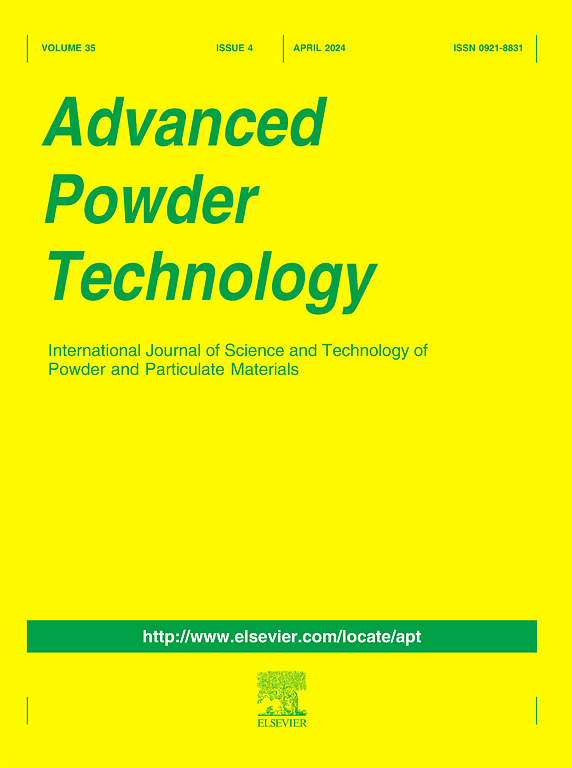原子层沉积法制备NiO-TiO2纳米纤维,改善对乙酰氨基酚的降解
IF 4.2
2区 工程技术
Q2 ENGINEERING, CHEMICAL
引用次数: 0
摘要
光驱动水处理方法因其有效降解有害污染物的能力而受到广泛关注。本研究采用溶胶-凝胶法结合静电纺丝法合成了聚乙烯吡咯烷酮(PVP)基二氧化钛纳米纤维,并在500℃下煅烧。然后以二(乙基环戊二烯基)镍和臭氧为化学前驱体,通过原子层沉积(ALD)在纳米纤维上沉积5、10和20 nm厚度的氧化镍(NiO)层。利用电子显微镜、表面积分析和各种光谱技术对纤维的结构和功能特性进行了表征。通过反射光谱和光致发光光谱证实,在TiO2纳米纤维中掺入NiO增强了光吸收,抑制了电荷重组,并改善了可见光下的光催化性能。光催化测试表明,5nm NiO的纤维表现出优异的性能,在可见光下,4小时内对乙酰氨基酚的降解率达到91%,而裸TiO2的降解率为70%。此外,5nm nio涂层纤维在5个循环中保持其性能,略微降低28%。反应种分析表明羟基和超氧自由基参与了降解过程。密度泛函理论(DFT)计算进一步阐明了NiO (5 nm)-TiO2复合材料(记为N5T)光催化效率的提高源于优化的电子-空穴分离和提高的光子能量保留。这些发现突出了N5T纳米纤维在水处理应用中的潜力,并为开发先进的光驱动催化剂提供了有价值的见解。本文章由计算机程序翻译,如有差异,请以英文原文为准。

Improved degradation of acetaminophen with NiO-TiO2 nanofibers synthesized through atomic layer deposition
Light-driven water treatment methods have garnered significant attention for their ability to effectively degrade harmful pollutants. In this study, polyvinylpyrrolidone (PVP)-based titanium dioxide nanofibers were synthesized using a sol–gel method combined with electrospinning, followed by calcination at 500 °C. Nickel oxide (NiO) layers of 5, 10, and 20 nm thickness were subsequently deposited onto the nanofibers via atomic layer deposition (ALD) using bis(ethylcyclopentadienyl)nickel and ozone as chemical precursors. The structural and functional properties of the fibers were characterized using electron microscopy, surface area analysis, and various spectroscopic techniques. The incorporation of NiO into TiO2 nanofibers enhanced light absorption, suppressed charge recombination, and improved photocatalytic performance under visible light, as confirmed by reflectance and photoluminescence spectra. Photocatalytic tests demonstrated that fibers with 5 nm NiO exhibited superior performance, achieving 91 % degradation of acetaminophen under visible light within 4 h, compared to 70 % for bare TiO2. Moreover, the 5 nm NiO-coated fibers maintained their performance over five cycles, with a slight reduction of 28 %. Reactive species analysis revealed the involvement of hydroxyl and superoxide radicals in the degradation process. Density functional theory (DFT) calculations further elucidated that the enhanced photocatalytic efficiency of the NiO (5 nm)-TiO2 composite (denoted as N5T) stems from optimized electron-hole separation and improved photon energy retention. These findings highlight the potential of N5T nanofibers for water treatment applications and provide valuable insights for the development of advanced light-driven catalysts.
求助全文
通过发布文献求助,成功后即可免费获取论文全文。
去求助
来源期刊

Advanced Powder Technology
工程技术-工程:化工
CiteScore
9.50
自引率
7.70%
发文量
424
审稿时长
55 days
期刊介绍:
The aim of Advanced Powder Technology is to meet the demand for an international journal that integrates all aspects of science and technology research on powder and particulate materials. The journal fulfills this purpose by publishing original research papers, rapid communications, reviews, and translated articles by prominent researchers worldwide.
The editorial work of Advanced Powder Technology, which was founded as the International Journal of the Society of Powder Technology, Japan, is now shared by distinguished board members, who operate in a unique framework designed to respond to the increasing global demand for articles on not only powder and particles, but also on various materials produced from them.
Advanced Powder Technology covers various areas, but a discussion of powder and particles is required in articles. Topics include: Production of powder and particulate materials in gases and liquids(nanoparticles, fine ceramics, pharmaceuticals, novel functional materials, etc.); Aerosol and colloidal processing; Powder and particle characterization; Dynamics and phenomena; Calculation and simulation (CFD, DEM, Monte Carlo method, population balance, etc.); Measurement and control of powder processes; Particle modification; Comminution; Powder handling and operations (storage, transport, granulation, separation, fluidization, etc.)
 求助内容:
求助内容: 应助结果提醒方式:
应助结果提醒方式:


